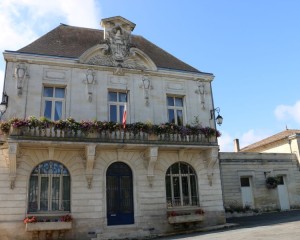Lussac is a town of the Greater Saint-Emilion area and the head town of the Canton of North Libourne. It is 9 km from Saint Emilion and its area is 2,343 hectares. Today, the town has 1,269 residents, and they are called the Lussacais and Lussacaises.
Lussac owes its origins to a Gallo-Roman character, Luccius, who moved into the region and built his city Luccianus in the vineyards, whose territory determines the first boundaries of the village.
Some may see another origin of the name of Lussac in the sacrificial stone on the mound of Picampeau, since the Gallic term "Lukus" meant "sacred wood", that is to say, a place of religious rites.
Lussac is dominated by the Gaulish megalith of the mound of Picampeau, where sacrifices were helded before the Christian era. Centuries later, Lussac is destroyed by the barbarian invasions. It is not until the 12th century that Cistercian monks highlight the region, especially for the church's reconstruction. Many wineries settled next to the Luccius villa and English Aquitaine made the local wines famous in England. Lussac gradually became a coveted town from the 17th century, in particular by the Bordeaux parliament who built several châteaux.
Lussac commerce also contributes to its dynamism. It has held up to twelve fairs per year since 1834.
In 2015, the National Council of the Towns and Villages in Bloom of France awarded two flowers to the town at the Contest of towns and villages in bloom.
The town has more than 11 km of rivers, mainly including: the stream of Gendarme, the stream De Lavie, the Palais and Petit Palais.
Lussac is a town near Saint-Emilion which is distinguished by its early viticulture and quality of its wines which are renowned.
The Lussac-Saint-Emilion is a dry red wine, within the still wine category. The appellation Lussac-Saint-Emilion is part of satellites wines of Saint-Emilion (more info here).
The Château of Lussac is located in the center of the village. The "primitive" castle belonged to the Montauroy family and was completely destroyed in 1898. The current building was built in five years, and is inspired by classical buildings that were in France in the 19th century.
The Church of Saint-Pierre, originally built in wood, was replaced in the 12th century, after a fire, by a Romanesque building, rebuilt in the 14th century. After being rebuilt, the church was ruined again in 1587, following the Religious Wars and finally fully restored in the 19th century. The bell tower and its spire were added and the nave modified. The restoration of Saint-Pierre's Lussac church was completed in 1874 with the installation of a bell.
The villa Luccius, of which some remains can still be seen, is a Gallo-Roman domain, originally named Lussac. The Luccius’s territory, a Gallo-Roman character, is a vineyard that determined the first village limits. There remains today a few foundations at the heart of a vineyard.
The Gaulish megalith of the mound of Picampeau, a stone where pagan sacrifices took place, also called Stone of the Martyrs, demonstrates the many Celtic rituals practiced at the time.
The House of wine and tourism of Lussac whose mission is to discover and promote the wines of the satellite town of Saint Emilion. Built in the late 18th century for Paul Montouroy it has also served as a town hall, police station, court house, private school, theater and eventually the property of the communal wine union.
A bike path offered by the Tourist Office through Lussac: "Churches and castles around Lussac" takes about 3 hours to complete (30 km). You can download the route here.
The town hosts a market every Thursday morning.
3 Place de la République
33570 LUSSAC
05 57 74 60 23
lussac-mairie@wanadoo.fr
OPENING DAYS OF THE CITY HALL
Monday and Wednesday: from 8:30 to 12:30 and from 2:00 pm to 6:00 pm
Tuesday and Thursday from 8:30 am to 12:30 am
Friday: 8:30 am to 12:30 am and from 2:00 pm to 5:00 pm

Grand Saint-Emilionnais Tourist Office
Le Doyenné - Place des Créneaux
33330 SAINT-EMILION





